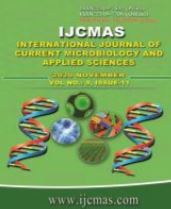


 National Academy of Agricultural Sciences (NAAS)
National Academy of Agricultural Sciences (NAAS)

|
PRINT ISSN : 2319-7692
Online ISSN : 2319-7706 Issues : 12 per year Publisher : Excellent Publishers Email : editorijcmas@gmail.com / submit@ijcmas.com Editor-in-chief: Dr.M.Prakash Index Copernicus ICV 2018: 95.39 NAAS RATING 2020: 5.38 |
A study was conducted in an ongoing field experiment started during Rabi 1988-89 in calcareous soil at Research Farm of Dr. Rajendra Prasad Central Agricultural University, Pusa, Bihar. The experimental design was split-plot with four fertilizer levels (0, 50, 100 & 150% NPK) in main plots and four levels of manures (no manures, compost @10 t ha-1, crop residues and compost @10 t ha-1 plus crop residues) in sub-plots. The present investigation was undertaken with objectives to investigate the effect of combined use of NPK and different organics (compost and crop residues) on oxidisable carbon fractions of soil. Application of fertilizers along with compost and crop residues resulted in significant buildup of soil organic carbon fractions. Very labile soil organic carbon was the maximum (3.75 g kg-1) in the treatment receiving both compost (10 t ha-1) and crop residues and it was 34.30% higher than that in the treatment receiving no manure application. The maximum non-labile soil organic carbon (6.06 g kg-1) was found to be in the treatment receiving both compost and crop residue and was 2.9, 3.41 and 36.48% higher than that in the treatments crop residue, Compost @ 10 t ha-1 and no manure application, respectively. The improvement in non-labile carbon fraction was more than labile carbon fractions suggesting higher carbon sequestration in the soil.
 |
 |
 |
 |
 |